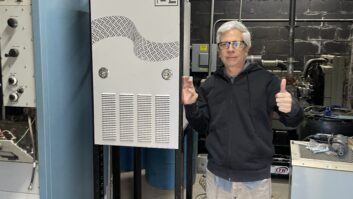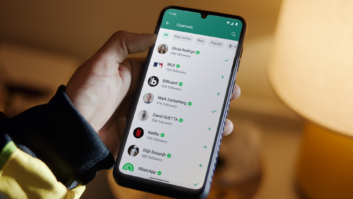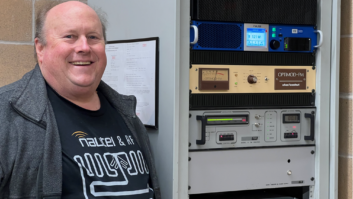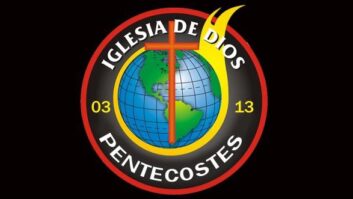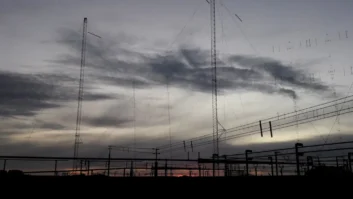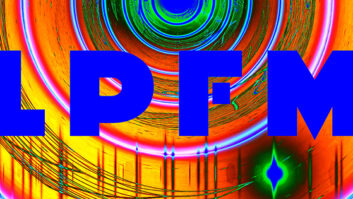Thoughts about the NAB Radio Show as the convention dwindles in our rear-view …
HD Radio power: Over recent months, the tone of the FM HD Radio power increase debate has moved from casual to more taut and back again.
Public radio engineers at NPR Labs, taking a cautious approach, have acted as something of a brake on the industry’s momentum toward a hike. In Philly we heard a lot about the results of testing, some of which NPR describes as sobering.

New FCC Commissioners Meredith Attwell Baker and Mignon Clyburn flank Rick Ducey, chief strategy officer of BIA Advisory Services. Photos by Jim Peck NPR is concerned about what happens when one station raises power and there is an impact on the listener experience of a closely spaced neighbor station, specifically if that neighbor station is airing content with the lower modulation density typical of many public stations (and others, including religious broadcasters).
Engineers for several large commercial broadcasters, on the other side of the divide, cited their own research supporting a hike and are pushing for a quick, full power increase, saying it’s critical to the success of the technology. And I heard from numerous manufacturers who also believe that a power hike is vital.
Any recommendation from NPR is likely to carry weight at the commission, and I suspect this is why the various parties are not content just to submit their own findings but to lobby for the shape NPR’s findings will take.
Tension was evident on the faces and in the remarks of some of the industry’s top-level radio engineering execs. In sessions of the Association of Public Radio Engineers and the NAB, various representatives contended over the implications of their dueling findings. Some joked about the standoff; but the tone sometimes was acrimonious. There was some unpleasant hallway gossip that gave a sour “us vs. them” feel to the proceedings.
NPR Labs engineers sought to defend the reasons and methodology for their tests and said they hope their work will help the industry reach a single compromise recommendation.

Radio World and several of our major advertisers saluted Gary Kline of Cumulus Media for receiving the Excellence in Engineering Award. I talked post-convention to a source who indicated that things are more collegial again and he hinted that such a recommendation might be near. [After the show and after the print version of this story went to press, Radio World reported online that NPR had told the FCC a 6 dB FM IBOC power increase could be implemented on an interim basis to achieve an increase in digital service coverage if sufficient safeguards and other measures are implemented. Read that here.]
We’ll continue to bring you coverage, such as the white paper by Russ Mundschenk and Milford Smith in the recent issue of RW Engineering Extra, and Mike Starling’s commentary in this issue.
IBOC Metrics and Boosters: IBiquity Digital and the NAB FASTROAD technology advocacy program announced completion of the first stages of a project to develop on-channel digital booster technology for FM IBOC.
Separately, a group of engineers has been working to make it possible to better characterize the performance of FM HD Radio transmitter facilities. That effort moved forward with announcement of the “Modulation Error Ratio” approach. (See sidebar.)
The economy: Business-minded broadcasters are hopeful (praying) that the economy has bottomed and that the months ahead will bring improved revenue and easier financing.
However I see no cure-all that is going to restore those lost billions in commercial revenue. We can look forward to more months of comments like “the news for radio revenue isn’t great but at least it’s not worse.”
FM IBOC TRANSMISSION QUALITY: Earlier this year the National Radio Systems Committee approved guidelines for measuring IBOC signals. Now the group has before it a standardized way to measure the transmission quality of an FM IBOC signal called Modulation Error Ratio. The hope is that equipment manufacturers will be able to offer the industry improved devices to measure signal quality.
Geoff Mendenhall, vice president of transmission research and technology at Harris, led the team developing the measurement standard. Engineers from iBiquity, Broadcast Electronics, Continental Electronics, Harris Broadcast, Nautel and others worked on it and reached consensus on the standardized method for measurement, they reported.
Mendenhall said the change would give “broadcasters confidence that their HD Radio transmission system is truly delivering a high-quality signal to their listeners.” The technique is described in an iBiquity reference document that the company submitted to the NRSC’s Digital Radio Broadcasting Subcommittee at the Sept. 23 meeting. The group will consider incorporating the technique into the NRSC-5 IBOC Digital Radio Broadcasting Standard as well as NRSC-G201 guidelines for measuring FM IBOC RF mask compliance, adopted this spring.
FM DIGITAL BOOSTERS: Broadcasters are a step closer to being able to use on-channel FM digital boosters to expand their coverage area. iBiquity Digital Corp. and the NAB FASTROAD technology advocacy program said the first stages of the project are complete. IBiquity is doing the work, which is co-funded by iBiquity and FASTROAD. The boosters, strategically located within a station’s coverage area, would transmit only the digital portion of the hybrid IBOC signal. IBiquity is targeting a booster design that is interoperable among transmission equipment manufacturers. The technology is reverse-compatible with existing receivers and supportable by existing FM IBOC broadcast products, such as exciters, through upgrades, according to the technology developer and NAB.
— From RW Newswatches Certainly there was much talk of how to extend radio’s cross-platform successes and otherwise thrive. It was not a downer mood in Philly. But one head of a medium-sized broadcast group told me this has been one of the hardest years he’s ever had, with layoffs of long-time employees and possibly more to come.
A tabletop show: I expected more protest from exhibitors once NAB started floating the idea of a tabletop exhibit format at next year’s show, which will be in Washington.
It will probably take place in a hotel, with vendor tables near the session rooms. A couple of exhibitors were vociferously opposed, but most seemed to greet the development as something of a fait accompli. Their general perception is that the fall show is too expensive for NAB in the current format; that the floor and exhibit hours have already shrunk considerably; and that the 2,500 people who attend (a generous estimate, in my opinion) can be served in a conference setup. One observer said the event now compares in scope to better regional trade shows like the Texas Association of Broadcasters event.
Whether downsizing the floor in this way will cause a self-fulfilling cycle of shrinking exhibits remains to be seen. NAB hasn’t finalized its plans, so the situation could change.
(We’ll have product news next issue.)
New face at the top: Former Sen. Gordon Smith made himself visible, and that was welcome. It’s hard to say what kind of guy the new head of NAB is. First impressions, not surprisingly, are of a smart man who is very much the politician.
He made no startling statements in his opening speech, in which he said he wants to be defined as “chief advocate for America’s broadcasters” and praised stations for their public service and contributions to their communities.
It’s intriguing that the association turned to a Republican, with a new Democratic administration not even in office for one year yet. But if Smith’s trappings — as a moderate and a “business-first” guy who enjoys Hill access — are accurate, the choice isn’t surprising given the personality of NAB membership. Most broadcast owners are not exactly wild lefties.
I can say this: The relief and enthusiasm among the association’s staff over this appointment were palpable. Insiders seem to feel they now have a boss who “gets it” when it comes to the all-important question of how to deal with lawmakers. Now let’s see how Smith puts his skills to work in issues like performance royalties, radio in consumer electronics and localism proposals.





